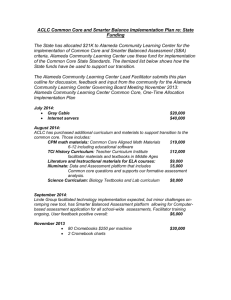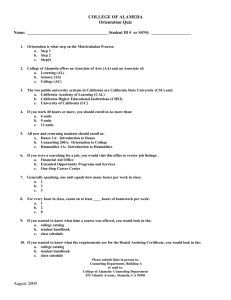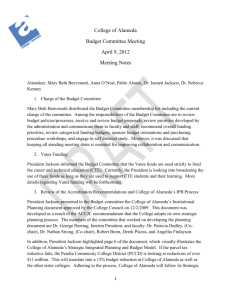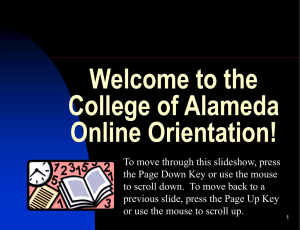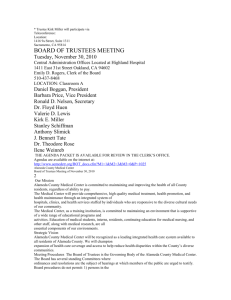AUSD Technology Plan
advertisement
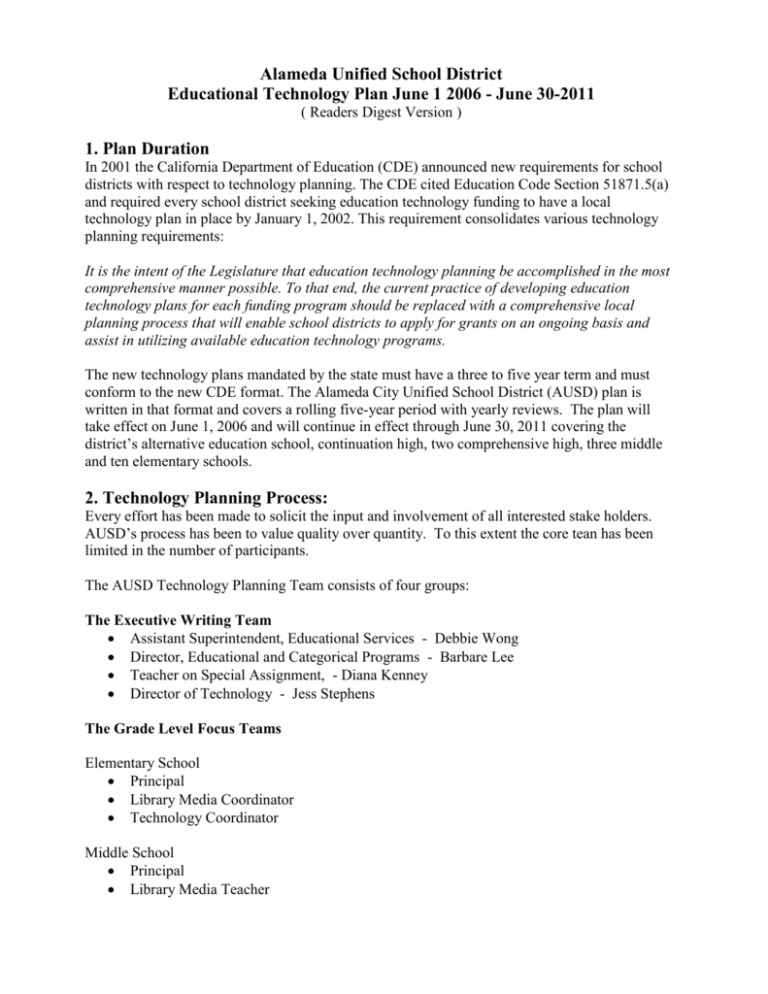
Alameda Unified School District Educational Technology Plan June 1 2006 - June 30-2011 ( Readers Digest Version ) 1. Plan Duration In 2001 the California Department of Education (CDE) announced new requirements for school districts with respect to technology planning. The CDE cited Education Code Section 51871.5(a) and required every school district seeking education technology funding to have a local technology plan in place by January 1, 2002. This requirement consolidates various technology planning requirements: It is the intent of the Legislature that education technology planning be accomplished in the most comprehensive manner possible. To that end, the current practice of developing education technology plans for each funding program should be replaced with a comprehensive local planning process that will enable school districts to apply for grants on an ongoing basis and assist in utilizing available education technology programs. The new technology plans mandated by the state must have a three to five year term and must conform to the new CDE format. The Alameda City Unified School District (AUSD) plan is written in that format and covers a rolling five-year period with yearly reviews. The plan will take effect on June 1, 2006 and will continue in effect through June 30, 2011 covering the district’s alternative education school, continuation high, two comprehensive high, three middle and ten elementary schools. 2. Technology Planning Process: Every effort has been made to solicit the input and involvement of all interested stake holders. AUSD’s process has been to value quality over quantity. To this extent the core tean has been limited in the number of participants. The AUSD Technology Planning Team consists of four groups: The Executive Writing Team Assistant Superintendent, Educational Services - Debbie Wong Director, Educational and Categorical Programs - Barbare Lee Teacher on Special Assignment, - Diana Kenney Director of Technology - Jess Stephens The Grade Level Focus Teams Elementary School Principal Library Media Coordinator Technology Coordinator Middle School Principal Library Media Teacher 2 High School High School Coordinator High School Library Media Teacher Community Stake Holders AEA President CSEA president Board Member Board Member District Specialty Users Assistant Superintendent, Business Services - Luz Cazares Assistant Superintendent, Human Resources - Brandon Kruger Director of Maintenance and Operations - Bob DeLuca Director of Secondary Education - Sean McPhertridge Computer Support Technician The Executive Writing Team: met on an ongoing basis for several months during the development of the plan. Grade Level Focus Teams, Community Stake Holders and the District Specialty User groups participated in the formative evaluation of the plan. These groups reviewed the working plan and offered feedback. The Executive Writing Team used the feedback to revise the plan. 3 Superintendent’s Message OUR MISSION is to deliver a world class educational program that will provide our students with the necessary learning and technology skills to achieve at their highest potential in education, work, and in their personal lives. We expect our students to become productive citizens in a global environment, with a strong sense of civic responsibility, and a deep respect for diversity and the rights of others. On behalf of the Alameda students, staff, administration, and Board of Trustees, we are pleased to present the Alameda Unified School District’s (AUSD) Five Year Educational Technology Plan. This plan supports our mission by integrating the use of technology into the instructional program. Our curriculum will require our students to use technology tools in their learning activities and reinforce their peersonal technical skills. This strategy will help our students develop their critical thinking and problem solving skills by using technology tools to seek out, retrieve, modify, create and present information with greater efficiency. Through consistent use of these tools, the student will become proficient in the use of technology, and will be better prepared to succeed in higher education and the global market. This plan delivers a balanced technology program to ensure that (1) our curriculum is making maximum use of technology to enhance student learning, (2) all of our students have equal access to modern technology, (3) all of our students have equal access to remote information through the Internet, (4) all of our teachers are trained to teach and learn through and with technology, and that (5) technology resources are delivered efficiently and equitably to each of our learners. 4 THE ALAMEDA UNIFIED SCHOOL DISTRICT’S TECHNOLOGY VISION IS TO BE: A well managed school system that delivers an exemplary educational program. Alameda’s graduates will possess the necessary academic, work, technology and life skills to participate, compete and succeed in a dynamic global environment. Because of our aggressive technology program, Alameda’s students are “Unbound” from the traditional school concepts of time, location, and age requirements. Our administrators and teachers will be committed to the effective delivery of a technology rich curriculum. Our curriculum will be performance based and reflect the use of research based learning theory. Our students will be required to demonstrate the technology skills they have acquired and apply them to solve authentic problems through rigorous projects and research based activities. Our graduates will be proficient in the use of information literacy skills to define the need for information, develop strategies to seek out, select and retrieve valid information, evaluate their reasoning process and conclusions, and present information through multi media techniques. All Alameda students will have ready access to current technology, modern computers and the Internet. The staff will be trained on how to teach with technology, use software to reduce time spent on administrative duties, and use email to communicate effectively with students, parents, other teachers and members of the community. Alameda’s citizens are encouraged to share the responsibility for each student’s academic success, and to provide their students with learning and civic involvement opportunities in the community. Lastly, The Alameda graduate will demonstrate a strong sense of civic and social responsibilities, a respect for cultural differences and the rights and property of others, and the necessary academic and technology skills to succeed in life. Alameda’s students will be prepared to enter the 21st Century as a responsible and productive citizen. 5 INTRODUCTION AND SUMMARY Alameda’s Mission is to provide its students with the necessary academic, personal and technology skills to succeed in higher education, the world of work, and in their personal lives. To carry out this mission, Alameda has implemented two major strategies that involve the use of technology: Alameda has implemented a Graduate Profile which requires that each student must demonstrate (1) high personal qualities in work habits and attitudes, (2) basic competence in reading, writing, mathematics, scientific principles, communications, and social sciences, as well as an appreciation for art, diversity and personal health, (3) the ability to think critically and solve complex problems, (4) effective interpersonal and collaborative skills, and (5) proficiency in the use of technology. Alameda will also implement an Equal Access Program that will provide all students with equal access to educational resources through the district’s Wide Area Network (WAN). This will allow the district to “bus educational information” to all students through the WAN, in lieu of “bussing the student” to educational information sites. The Original Technology Plan was developed in 1996-97, and established standards for the networking of all schools and the development of student technology user skills. One of the most significant accomplishments of this plan was the connecting all of schools together through a district wide fiber optic WAN. This WAN placed the district in an outstanding position to provide all students with the ability to conduct project based research through the Internet, and to communicate easily with others, anytime, anywhere. There was a need to update the original plan and establish measurable goals for the (1) integration of technology use into the curriculum, (2) procurement of an adequate number of computers, (3) completion of the district wide network infrastructure, and the (4) training of staff to teach with technology over the next five years. The second Technology Plan was approved by the Board in June of 2001 and subsequently was E-rate certified, was developed by a technology task force composed of teaching specialists from all subject areas as well as representatives from all administrative support areas. The plan supported (1) the Graduate Profile by integrating the use of technology across the curriculum to develop the student’s academic, critical thinking, problem solving and technology user skills, and (2) the Equal Access Program by implementing a district wide network of computers that will provide all students with equal access to educational resources throughout the district and from remote sources. That plan described how Alameda will integrate technology into the student learning process by implementing district wide standards through five technology goals: Curriculum – To improve student learning through technology rich instruction. Computers – To provide all students with equal access to modern technology. Connectivity – To provide all students with equal access to the Internet. Competence – To train teachers/support staff on how to teach with technology and improve job performance. Corporate – To deliver technology resources efficiently and equitably to all learners. 6 Alameda’s School Board started a Strategic Planning Process in the fall of 2002. Stakeholders from throughout the district – community members at-large, parents, students, administrators, teachers, classified staff and Board members – engaged in a rich dialogue defining and prioritizing our overall district direction with technology woven into the entire fabric of the plan as a tool to enhance teaching and learning, management of student information, formative and summative assessments, and storage and retrieval of data for a well informed decision making process that would maximize equity, access and achievement for all of our students. The Strategic Focus of this plan is “Every student will meet or exceed all AUSD and state standards as measured by district and state assessments.” In order to help us meet this strategic focus, the district has adopted specific curricular goals and academic content standards at all the grade levels. The following documents and programs summarize these goals. Grade Level Expectations for all students in Grades K-8 list essential content standards in language arts, math, science, and social studies. The K-5 Report Card is a standards based document. Students are assessed on trimester mastery of essential standards, taken from the Grade Level Expectations document. Course Objectives for all high school level English, math, science and social studies courses are outlined in high school course catalogs. The Enhancing Education Through Technology Formula Grant Program (ETTFG), funded by the federal government, has mandated additional components in the technology plan. More specifically, the “Effective Collaborative Strategies With Adult Literacy Providers to Maximize the Use of Technology,” and “Effective, Researched-Based Methods and Strategies” sections were added. Keeping the five goals of the 2001 technology plan, and using the strategic plan as a framework with the state and federal mandates as guidelines, this plan has been reformatted and updated to begin our technical journey therough the school year 2011. This plan will be reviewed and updated on a yearly basis with changes reported to the school board. 7 The Alameda Unified School District believes that all planning processes should support the underlying tennants of the districts values and objectives, namely quality education for your students. This Education Technology plan was developed with the following goals of the Districts Strategic Planning Process ALAMEDA UNIFIED SCHOOL DISTRICT STRATEGIC PLAN The Alameda Unified School District embarked upon a 15-month Strategic Planning Process involving over 625 stakeholders representing students, parents, teachers and staff, site and district administrators, community leaders, and Board members. The resulting Strategic Plan provides a road map for achieving educational excellence that everyone in the district community comprehends and supports, and for aligning district resources behind the successful accomplishment of high-priority goals. The districts Strategic Plan contains a set of core calues, which underscore the district’s commitment to diversity, and to the development of the whole person—emotional as well as intellectual intelligence. A new Mission Statement was defined affirming that AUSD is a team unified to ensure that every school creates a learning environment where every student succeeds. All of the goals contained in the Strategic Plan are linked to a Strategic Focus namely, every student will meet or exceed all AUSD and state standards as measured by district and state assessments. Working within agreed-upon Priority Goal Areas, a set of 12 Goals have been identified. Curriculum/Instruction/Assessment Goal#1: A clearly defined core curriculum, aligned with state standards, is being used consistently district-wide, and all educators are implementing effective instructional practices Goal#2: A Staff Development Plan supports all educators in being more effective Goal#3: Every student is being taught by fully credentialed, highly qualified teachers Goal#4: A comprehensive assessment system is providing ongoing individual student data that enables teachers to be more effective in improving student performance Strategic Intervention and Support Goal#5: All at-risk students have equal access to effective intervention programs that helps them get back on track academically Goal#6: Every student graduates from high school Goal#7: All limited-English-proficient students become proficient in English and reach high academic standards Goal#8: Every Title I school has a high-quality Early Childhood Education Program Student Involvement and Engagement Goal#9: All students have the opportunity to be actively involved in decisions regarding their educational experiences 8 Safe Schools Goal#10: All students are being educated in learning environments that are safe and conducive to learning Vocational/Career/Adult Education Goal#11: All students are prepared to succeed in college and/or their career choice because they have been exposed to a range of options that include career and technical education experiences Communications and Community Engagement Goal#12: An effective communication system promotes information exchange, and engages our diverse population in support of every student being successful 9 3.0 CURRICULUM COMPONENTS 3.a. Description of teachers’ and students’ current access At the K-6 levels, technology is used to supplement the curriculum in core content areas. A variety of software programs such as KidPix, Inspiration, Accelerated Reader, SuccessMaker and Jumpstart for problem solving are available and challenge the K-6 students. At the middle schools, students have access to Power Point, Excel, Word, the Internet, MathTech and SuccessMaker enterprise curriculum. All students including Special Education students, English Language Learners, and GATE students, are expected to access and utilize the tools of technology to further their learning. 3b. Description of the district’s current use of hardware and software to support teaching and learning. The Alameda Unified School District is located on the island City of Alameda on the San Francisco Bay. The district serves 10,163 students with a staff of 475 teachers, 10 counselors, 405 classified staff, and 58 administrators. The current student enrollment includes 2,025 Limited English Proficient students, 362 Special Day Class students and 32% are eligible for the free/reduced lunch program. The student population is very diverse with an ethnic composition of 23% Asian, 2% Pacific Islander, 11% Filipino, 11% Hispanic, 14% Black and 38% White. Technology and information literacy skills are integrated into district standards and core curricula beginning in first grade and continuing through high school. Students engage in self-paced computer assisted learning environments. Teachers are beginning to use the emerging technology of distance learning in the classroom. 3.c. Summary of district’s curricular goals As stated befor the district developed a Strategic Plan to drive all district activivites. Developed within that plan was the Graduate Profile: Our graduates ( students ) will: Achieve state and local standards Display responsibility, self-esteem, self-management, integrity and honesty Work well and cooperates with others Demonstrate knowledge of career options and the pathway to their attainment Applies technology as a tool for learning and career preparation Understand and participate in the democratic process To achieve those outcomes the district has adopted content and performance standards for all curricular areas in accordance with the State of California timeline for adoption. The curriculum is content-driven and performance based. Students are expected to acquire specific skills, demonstrate what they learn and apply it to authentic and rigorous assignments. Our Technology Plan is designed to support our Local Agency Plan (LEA), which requires us to set five-year improvement targets for districtwide student achievement in mathematics and literacy. 3d. List of clear goals and a specific implementation plan for using technology to improve teaching and learning by supporting the district curricular goals and academic content standards. Overall Teaching and Learning Goal: To improve student learning through technology rich instruction The following curriculum goals support teaching and learning for all students, including special education, GATE, and English Language Learners (ELL). Goal 3.d.(1). – Literacy: Technology will be used for teaching and learning so that 90% of all students will meet grade level language arts content standards, word analysis, fluency, systematic vocabulary development and reading comprehension by June 2008. Goal 3.d.(2). – Mathematics: Technology will be used to support teaching and learning so that 90% of all students will meet grade level mathematics content standards in number sense and Algebra and functions by 2009. 3e. List of clear goals and a specific implementation plan as to how and when students will acquire technology and information literacy skills needed to succeed in the classroom and the workplace. Alameda will implement the Student Technology User Skills continuum for grade levels K-3, 4-5, 6-8 and 9-12. This grade level continuum for technology skills will (1) show where the skill is introduced and mastered, (2) how the skills will be used at that grade level, (3) coincide with the technology curriculum objectives that are established, and (4) tied to the other curriculum benchmarks and national technology standards for each curriculum subject area. 3f. List of clear goals and a specific implementation plan for programs and methods of utilizing technology that ensure appropriate access to all students. Alameda Unified has implemented an Equal Access Program to mitigate the effects of the digital divide and the achievement gap. One feature of this program provides all students with equal access to educational resources through the district’s fiber optic Wide Area Network (WAN) and 100BaseT Local Area Networks at each campus extending to each classroom, Media Center and computer lab. This allows the district to “bus educational information” to all students, regardless of background or special needs, through the WAN, in lieu of “bussing the student” to educational information sites. This infrastructure serves after school programs as well as normal school day activities. 11 3g. List of clear goals and a specific implementation plan to utilize technology to make student record keeping and assessment more efficient and supportive of teachers’ efforts to meet individual student academic needs. Existing background: The district has a comprehensive assessment system that provides ongoing individual student data that is diagnostic, formative, and summative in nature supported by technology at the classroom, site, and district levels. Progress is communicated to parents and students through a clear and consistent grading system. Multiple sources of data are used to drive the decision-making process districtwide. A multi facetted assessment technology system is in place which allows administrators and teachers to easily access student data at the teacher, site, and district level to inform decision making. 3h. List of clear goals and a specific implementation plan to utilize technology to make teachers and administrators more accessible to parents. The parents and business community are encouraged to share the responsibility for each student’s academic success. This involvement is encouraged through (1) direct invitations to district site council meetings, (2) business contributions for the purchase and installation of hardware (e.g.Alameda Power installation of fiber optic network, Arthur Andersen implementation of the Arthur Andersen Community Learning Center), (3) parent participation in the planning of programs such as the digital high school initiative, (4) the issuance of information packets on a variety of topics, (5) a district newsletter which highlights site and district events for community participation, and (6) the use of parent volunteers in the libraries, computer labs and classroom. 3i. List of benchmarks and a timeline for implementing planned strategies and activities. Benchmarks and timelines have been incorporated in the charts found in this section. The charts have been designed to assist teachers administrators and students implementing the plan to easily discern what steps will be taken by whom and when. 12 3j. Description of the process that will be used to monitor whether the strategies and methodologies utilizing technology are being implemented according to the benchmarks and timeline Evaluation Instrument(s) & Data To Be Collected California School Technology Survey • Percentage of teachers' professional use of technology • Percentage of administrators' use of technology • Percentage of student use of technology • Amount of time technology used in Reading/language literacy and mathematics CTAP Technology Assessment Profile • Teacher responses for personal use for classroom management and instruction • Teacher responses for student use Frequency of Collection Annually Annually Process to Monitor and Persons Responsible the K-8 and 9-12 Directors, the Director of Information Technology and the Coordinator of Assessment will review synthesize and analyze data and make adjustments to the type and frequency of activities and strategies as as well as provide data analysis to the Superintendent of Schools and the the Assistant Superintendent of Educational Services. The K-8 and 9-12 Directors The site principals Student Work Products (such as Power Point presentations, Videos, MultiMedia Projects) • Samples at elementary, middle and high schools • Student work produced based on sample lessons At the end of each semester Standardized Tests • CAT 6 Language Arts scores • CAT 6 Mathematics scores • Hiqh School Exit Exam scores (CAHSEE) Districtwide Assessments • Language Arts scores • Mathematics scores School Technology Plans • Goals and Implementation Activities and Strategies Results from the PLATO, New Century and SuccessMaker coursewares Annually The K-8 and 9-12 Directors The Director of Assement Annually The K-8 and 9-12 Directors The Director of Assement Annually The K-8 and 9-12 Directors The Director of Information and Technology The K-8 and 9-12 Directors The Director of Assement Annually 13 4.0 PROFESSIONAL DEVELOPMENT COMPONENT 4.a. The information on the district’s current use of technology is delineated in Section 3.0. Additionally, the following data, based on a sampling of our staff, is provided : Summary of Staff Profieciency Use word processing application Send and reply to E-mail messages Ability to load software onto a personl computer Use search tool to locate information on the Internet Use desktop publishing or “banner-maker” application Use spreadsheet or file management application for class record keeping Coach students on importance of information literacy Locate lesson resources on Internet and incorporate into curriculum Discuss larger issues involving student use of technology Use variety of tech tools and media to advance understanding of ed tech Able to use a variety of pre-structures courseware Acknowledged by peers as role model educator Able to instruct others in application of education tech tools Am now using tech skills to mentor other teachers Troubleshoot workstation or network 95% 89% 88% 87% 67% 67% 59% 56% 49% 48% 39% 33% 32% 22% 16% The district believes that teachers and administrators need professional development opportunities and the time to develop and practice the necessary skills to become proficient technology using educators. In an effort to have every teacher and administrator meet the level II professional proficiencies by 2008, the district will create a Training of Trainers program. This program will consist of elementary, middle and high school teachers interested in teacher training and staff development. These teachers will participate in up to 10 hours of training designed to enable them to provide 10 hours of training at their school sites. This training will be aligned to the professional teacher’s proficiency in Computer-Based Technology standards detailed in the California Commission on Teacher Credentialing Standard 16 – (for the Multiple and/or Single Subject Teaching Credential) Using Technology to Support Student Learning. Hardware and software necessary to perforn the required training at the sites will be provided to the teachers. 14 Student performance and achievement will be the primary design criteria of the TT program’s professional development workshops and trainings. These workshops will aide teachers to devise strategies for student inquiry, portfolio creation, and journal keeping while conducting reviews of individual students. The TT program will employ best teaching practices for adult learners incorporating time for collaboration and individualized instruction. The TT committee will implement long term professional development processes that reflect both site based and individual learning needs aligned with state and district standards. Workshops focused upon student Internet safety, technology ethics, and acceptable use will be conducted annually for faculty and staff 4b. List of clear goals and a specific implementation plan for providing professional development opportunities based on the needs assessment and the Curriculum Component goals, benchmarks, and timeline. 4c. List of benchmarks and a timeline for implementing planned strategies and activities. Professional Development Goal: Alameda will implement an ongoing staff development program to train all teachers and administrators on how to use technology to support the curriculum goals in this plan and to enhance staff and student information literacy skills. 4d. Description of the process that will be used to monitor whether the professional development goals are being met and whether the planned professional development activities are being implemented in accordance with the benchmarks and timeline. District staff members will correlate student learning assessment data with multiple assessment measures of staff technology proficiency to assess overall program effectiveness. District staff will perform an annual review of the data and performance against technology plan timelines to recommend modifications to the Superintendent. 5.0 INFRASTRUCTURE, HARDWARE, TECHNICAL SUPPORT AND SOFTWARE COMPONENT 5.a, b The hardware, Internet access, electronic resources and technical support that already exists in the district are described in Exhibit ??. Additional details are provided below: Single Computer Standard. Alameda has moved to a Microsoft Windows based computer standard for both administrative and instructional applications. Migration of all servers and client platforms was completed by 2005. Computer Technical Support Site Level Technology Coordinator. Alameda will increase the staffing of the current site technology coordinator from one prep period per week to 0.5 FTE for schools with more than 500 students, and to 0.30 FTE for schools with less than 500 students. The site technology coordinator will assume full responsibility for the site level technologytraining program, and will off load the district level staff for computer/network support, maintenance and repair. Network Security. Alameda will establish network policies for the protection of equipment, programs and data files. This will include operating system policies, user and group privileges, physical and logical server security, and firewalls between district campuses and the Internet. Network Support. Alameda will establish a core network staff capability, and will outsource supplemental network maintenance support where it is advantageous to pay a vendor versus add FTEs. District Staffing: Proposed Formula Proposed FTE years 2006 - 2011 Yr 1 Yr 2 Yr 3 Yr 4 Yr 05 07 08 09 10 11 Director of Technology Services ( existing ) Network Manager Network Administrator / Analyst ( existing ) SIS Administrator ( existing ) Database / Server Administrator Help Desk Staff - ( 1 existing ) (1 per 1500 Workstations) Help Desk Staff Network Administrative Assistant / help desk Teacher on Special Assignment 1.0 1.0 1.0 1.0 1.0 1.0 1.0 1.0 1.0 1.0 1.0 2.0 1.0 1.0 1.0 1.0 1.0 2.0 1.0 1.0 1.0 1.0 1.0 3.0 1.0 1.0 1.0 1.0 1.0 3.0 1.0 0.0 1.0 1.0 1.0 1.0 1.0 1.0 1.0 1.0 1.0 1.0 1.0 1.0 1.0 Total staff by end of each school year 8.0 10.0 10.0 11.0 11.0 Projected wages Bennifits ( 30% ) Total ( ,000 ) 560 165 725 655 195 815 665 200 865 715 215 930 725 220 945 16 6.0 FUNDING AND BUDGET COMPONENT 6. a., b., c. and d. The district is committed to securing ongoing, stable funding to support the curriculum resources, staff development, technology tools, infrastructure and technical support which are necessary to implement the Technology Plan. The district and schools will develop technology standards, processes and procedures to ensure the effective deployment of technology and promote cost effective management practices at all levels. 6.e. Coordination and Management: At the district level, the Superintendent, the Chief Financial Officer the Assistant Superentendent of Educational Services and the Director of Information Technology will meet twice a year coinciding with the state budget projection in January and during the May revise to analyze the data from the Curriculum, Professional Development and Infrastructure components of the Plan in order to determine the degree to which the Plan is being implemented and the level of funding support needed to accomplish its stated goals and objectives. The District budget, prior to Board approval in June, will include funding to ensure that the technology goals are progressively being met. 7.0 MONITORING AND EVALUATION COMPONENT 7.a and b. Implementation of the Plan: As indicated in each section of the plan, the district will conduct an ongoing formative evaluation and assessment of impact on student learning and attainment of the district’s curricular goals. Impact of Technology on Teaching and Learning: The district will develop strategies to assess the impact of a standards-based technology embedded curriculum, taught by well trained teachers, on student achievement. 7.c. The Monitoring and Evaluation Subcommittee will use the data to determine the overall effectiveness of the plan and to assess the need to adjust or modify the activities, timelines, and budgets. The committee will prepare an implementation status report on the progress toward the plan goals and the completion of activities and submit the report and budget recommendation to the Superintendent on an annual basis. Furthermore, the report will be shared with stakeholder and other supporters of Alameda City Schools. 8.0 ADULT LITERACY PROVIDERS Within the Educational Services Office, the Director of Secondary Ed/ROP and the Principal of the Adult School have collaborated to provide adults access to technology through several existing programs. The Regional Occupational Program (ROP) offers a variety of computer training opportunities such as Computer In Business, Desktop Publishing, A+/Web Design, and Cisco Network Cabling Technology. These free classes are open to all residents of Alameda, who are at least 16 years old. Classes are offered mornings and afternoons at high school campuses. These training programs provide citizens within the community with career guidance, hands-on training, and job placement assistance to help ensure success. Through the Adult School, Adult Computer Literacy Courses are open to all adults in our community. Eligibility requirements are that the participants are eighteen years old. Courses offered are Introduction to Computers, Windows Operating System, Microsoft Suite, Computer Graphics/Photo Editing, Upgrading to Windows XP, Introduction to the Internet, Creating a Web 17 Page and PC Maintenance Technician A+ Certification. These are lecture style courses that also involve a specific amount of hands-on lab time. 9.0 RESEARCHED-BASED METHODS 9.a, b. Curriculum Integration Our Technology Plan emphasizes the integration of technology into the curricular framework rather than an “add-on” or a “stand alone” strategy. The following research data supports this pedagogical approach. Furthermore, our Plan, based on available research, also emphasizes technology access for ALL Students as a valuable tool to enhance learning and improve student achievement. 1) Integration within the curriculum framework 2) Integration with curriculum framework strengthens information literacy skills 3) Learning Styles and Special Needs 4) Technology Integration and Student Achievement 9.a, b. Staff Development Research Our Technology Plan is designed to provide a strong staff development program that is on-going for teachers and administrators particularly in embedding electronically based resources in the curriculum and accessing e-learning materials. Research has shown that professional development for those closest to the classroom done in a timely manner is invaluable in improving student achievement. 1) Improving Student Achievement 2) Effective training models 3) Which strategies build teacher confidence and interest in technology? 9.c. Innovative Strategies for using Technology To ensure that rigorous academic content are available to all our students who choose to access advanced placement (AP) courses the District has made available AP courses through distance learning. Server based courseware and remote network access enables this mode of instruction. Based on needs and demands the District plans to expand this program from one (Honors Shakespeare) to four (Honors Physics, Intro to C+, Honors Sociology and Honors Shakespeare) in order to impact the achievement gap. We will continue this strategy to offset the effects of budgetary constraints and insufficient resources.
